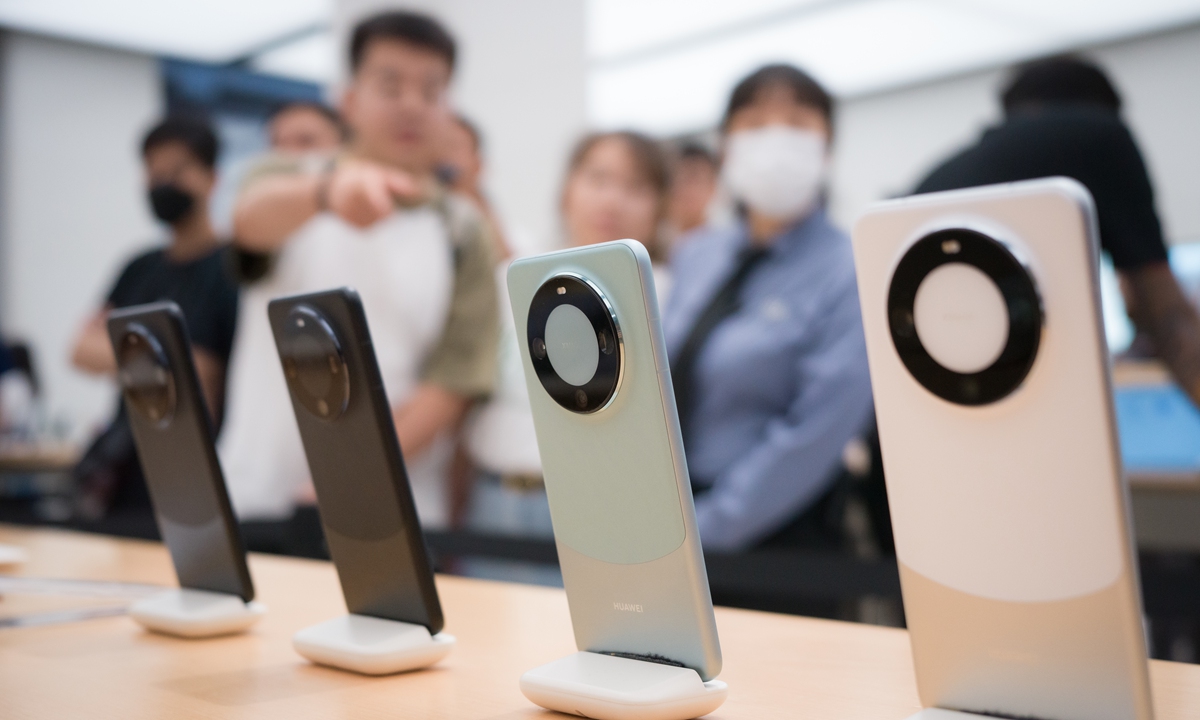
Consumers queue up to experience the new Huawei Mate 60 Pro on September 3, 2023, in Shanghai. Photo: VCG
Huawei’s launch of a 5G-capable smartphone series in late August is believed to represent a major breakthrough in chip technology after years of US sanctions, and the launch of new products on Monday shows the tech giant’s ambitions for constructing a homegrown software ecosystem that could be a game-changer for the global market, analysts said.
Huawei unveiled a range of what it calls “all-scenario” products at a high-profile launch event in Shenzhen, South China’s tech hub, on Monday, including new tablets, smart screens, smartwatches and earphones, all powered by its self-developed HarmonyOS system.
The launch event generated a buzz across the nation, as consumers believe it marks a comeback for Huawei to the center of the stage after overcoming the chip stranglehold imposed by US sanctions.
Observers told the Global Times on Tuesday that a highlight of the event was the M-Pencil (third generation), the world’s first terminal product to adopt Huawei’s NearLink technology – a new short-range wireless connection technology that could be viewed as a potential challenger to Bluetooth and Wi-Fi.
The Huawei Mate 60 smartphone series, MatePad Pro 13.2, and Freebuds Pro are among the first devices shipping with the NearLink standard.
The technology is not a new one, but it marks significant progress for Huawei in commercializing NearLink technology and mass-producing various products, which is a critical step, Zhang Hong, a close follower of Huawei and a veteran industry analyst, told the Global Times on Tuesday.
Traditional wireless connection technologies such as Bluetooth and Wi-Fi are facing increasing demand for high speed and low latency in the face of an increasingly large number of smart terminals and human-computer interaction scenarios in the new era, and NearLink was born to make up for the deficiencies, Zhang explained.
“The technology, which will be immune from US sanctions, could be revolutionary if it proves to be a success,” Zhang said.
According to Huawei, NearLink, which involves collaboration by more than 300 leading enterprises and institutions at home and abroad, combines the advantages of traditional wireless technologies such as Bluetooth and Wi-Fi into one standard set, resulting in “significantly improved performance.”
Compared to traditional wireless connections, NearLink reduces power consumption by 60 percent, increases the data transmission rate by 6 times, reduces latency and supports up to 10 times more connections, the company said.
But there are also alternatives in the market, including the ultra-wideband (UWB) technology Apple is developing for its devices, indicating a long road ahead for the Chinese tech giant, Zhang said.
Industry players said the move was also another precautionary step for the tech giant in case of more potential US sanctions.
In 2019, Huawei's membership in global industry organizations, including the Wi-Fi Alliance, the Bluetooth Technology Alliance (Bluetooth SIG), and the JEDEC Association, was suspended after the US added it to an Entity List. Although the memberships were restored later, Huawei’s smartphones face the possibility of losing their Bluetooth or Wi-Fi functionality if the sanctions get tougher.
In August, Richard Yu Chengdong, CEO of Huawei’s consumer business, announced NearLink’s integration into the ecosystem of HarmonyOS for consumer devices, in an effort to trial and apply the technology in a wider range of terminals and devices.
There are now more than 30 operating systems in China that are based on HarmonyOS open source, covering industry terminals, mobile phones, tablets and home terminals. In total, there are approximately 600 million users, ranking third in the world, Huawei founder Ren Zhengfei said in a recent interview with Liu Yadong, dean of the School of Journalism and Communication at Nankai University.
“From NearLink to the homegrown HarmonyOS, Huawei is clearly moving steadily forward without foreign tech. The momentum has not been halted by the US sanctions,” Zhang said.
However, observers pointed out that it will take time to develop the new ecosystem, and it will be even tougher for the whole system to be received by the global market and shake industry giants such as Android while sanctions are still in place.

